Introduction
Arrow arum is an obligate wetland herbaceous aquatic perennial native to Florida which can grow from 2 to 3 feet in height. It thrives in marshy depressions, lake shorelines, swamps, and wet woodlands. It can also grow easily in standing water up to 6 feet deep as well as in boggy soils. The common name is derived from the plant's pronounced arrowhead-shaped leaves, which are typically 10 to 12 inches long and 5 to 6 inches wide. The leaves emerge annually from perennial bulbs tufted with thick fibrous roots and are clustered on long, succulent stalks. The undersides of these leaves are whitish with three prominent veins (Lady Bird Johnson Wildflower Center 2015).
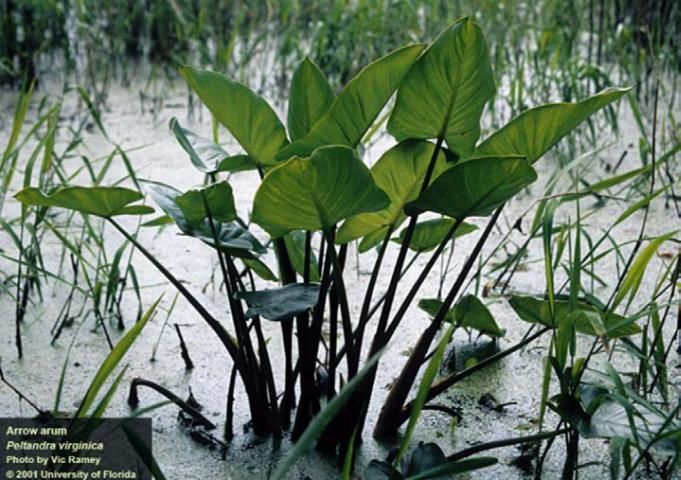
Credit: UF/IFAS Center for Aquatic and Invasive Plants
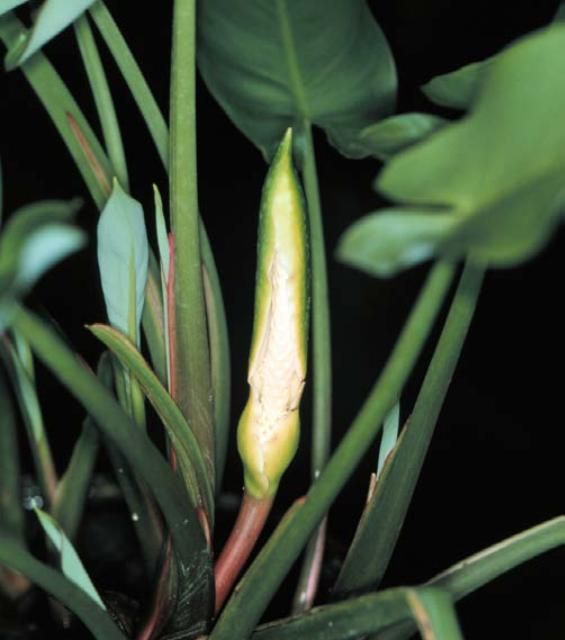
Credit: David Sutton
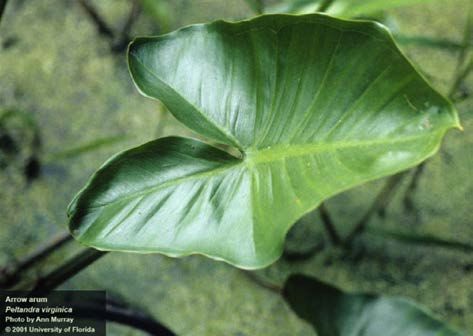
Credit: UF/IFAS Center for Aquatic and Invasive Plants
Arrow arum flowers from May to July (although the species can flower almost year-round in tropical environments) and is monoecious (separate "male" and "female" flowers are produced on each plant), with a spathe and spadix inflorescence supported by a long stalk. The tiny white to pale yellow flowers are borne on the spikelike spadix, with male flowers near the top and fertile female flowers near the base. The spadix is surrounded by a partially closed white to pale yellow spathe. The flowers have an odor that attracts flies. The primary pollinator is the Chloropid fly (Elachiptera formosa). Adult Chloropid flies lay eggs on the spadix, eat pollen, and cross-pollinate the flowers as they move between inflorescences (Illinois Wildflowers 2015). Green to brown berry-like fruits filled with a mucilaginous or jellylike pulp are produced in clusters. Each fruit is up to 0.5 inches long and contains 1 to 3 seeds. After the fruits separate from the flower stalk, they turn black and float away from the parent plant. Arrow arum is not considered salt-tolerant and prefers a sandy or organic muck soil with an acidic pH.
Arrow arum is sometimes confused with pickerelweed (Pontederia cordata) and duck potato (Sagittaria latifolia). Pickerelweed has heart- or sword-shaped leaves and blue to purple flowers. Duck potato has arrowhead-shaped leaves, but its leaves' veins radiate from a common point while the veins in arrow arum leaves are pinnate (lateral veins attached to a central vein) (Illinois Wildflowers 2015). The genus name of arrow arum (Peltandra) comes from the Greek words "pelte" (small shield) and "aner" (stamen, in reference to the shieldlike contour of the stamens).
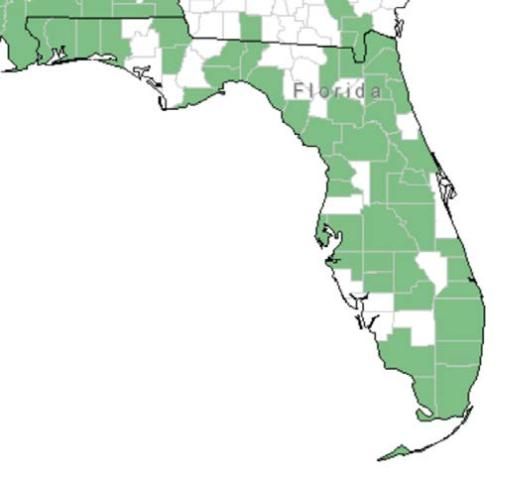
Credit: USDA NRCS
Classification
Common Names: arrow arum, green arrow arum, tuckahoe, green arum
Scientific Name: Peltandra virginica (L.) Schott
Family: Araceae (arum, aroid family)
Distribution and Habitat
Arrow arum commonly inhabits shallow water areas of marshes, bogs, swamps, stream bottoms, river bottoms, lakes, wet woodlands, pineland swamps, and ditches (Wunderlin and Hansen 2008). It has been found in slow-moving fresh waters and on tidal flats along the edges of rivers and streams (USDA NRCS 2015). It can also be found throughout Florida, the eastern US, and southeastern Canada. Arrow arum's native range spans from Maine to Ontario and Michigan, then south to Florida, Louisiana, and Missouri (USDA NRCS 2015). Plants are hardy in USDA Zones 5 through 10. Minimum winter temperatures in zone 5 average -20 to -10°F while in zone 10 minimum winter temperatures range from 30 to 40°F.
Propagation
Arrow arum can be propagated from seeds or root bulb division. In nature, arrow arum relies on seed production for re-establishment and population distribution. When the fruit falls off the stem into the water, the fruit coating swells and ruptures. The seed separates from the fruit and sinks. If conditions are adequate, the seed germinates. This process can be easily replicated in the greenhouse and in cultivated fields. Poor germination (~10%) occurs at room temperature if the seeds are left in intact fruits, so for maximum percentage germination under these conditions, remove the skin and pulp of the fruit (West and Whigham 1975). Seeds and fruits can be stratified (stored at 5°C) for up to 4 weeks with no reduction in germination; in fact, germination of seeds in intact fruits can be as high as 90% after stratification (West and Whigham 1975). However, drying greatly reduces germination. As few as 5 days of dry conditions can result in no germination at all (West and Whigham 1975). Arrow arum also can be propagated by root bulb divisions. Root bulbs tend to form in layers around the root mass. After the root mass is unearthed, the bulbs can be separated from the mass and transplanted. One mature plant may produce up to ten divisions.

Credit: Lyn Gettys
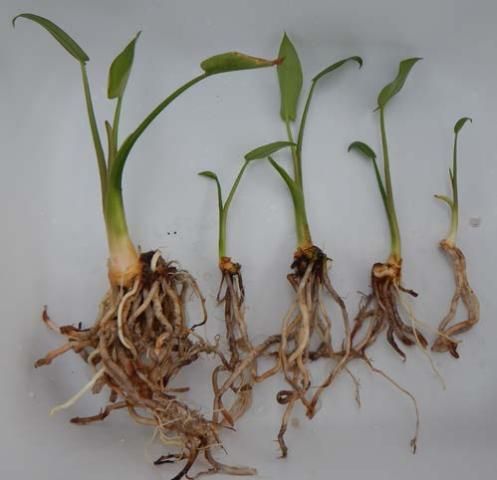
Credit: Lyn Gettys
Other Uses
Arrow arum can be used as an ornamental in water or bog gardens and can be planted either directly into the native substrate or in containers or tubs. Because its root masses often knit together, arrow arum has been used to stabilize submersed sediments. The foliage and stems form a wave-deflecting barrier, and the foliage also provides cover for waterfowl, wading birds, aquatic mammals, and insects. The berries are a food source for wood ducks, king rails, mallards, muskrats, and certain turtles (Illinois Wildflowers 2015). Native Americans used the dried, pulverized roots as flour for bread. The fruit was sometimes cooked and eaten like peas. That said, consumption of fruits that have not been boiled for at least 8 or 9 hours "will make a man for the time franticke or extremely sicke" (Austin 2004). The roots and foliage of arrow arum contain calcium oxalate crystals that can irritate the gastrointestinal tract, swell the throats of sensitive individuals, and cause kidney failure, so months of drying and processing are necessary to detoxify these plant parts before they are used in foods (Austin 2004). You should NEVER eat field-collected plants because many species have very similar appearances, and you could accidentally consume something toxic.
Summary
Arrow arum is a native aquatic and wetland plant that is a welcome addition to water gardens, aquatic ponds, and wetland restoration and mitigation sites. The species is broadly adapted and extremely common throughout Florida, and its perennial nature assures a stellar performance year after year. Arrow arum is considered a beneficial native plant that brings a number of desirable characteristics to almost any aquatic setting, including soil stabilization and food and shelter for aquatic fauna.
References
Austin, D. F. 2004. Florida Ethnobotany. Boca Raton, FL: CRC Press.
Illinois Wildflowers. 2015. "Arrow arum." Accessed June 15 2015 at http://www.illinoiswildflowers.info/wetland/plants/arrow_arum.html
Lady Bird Johnson Wildflower Center. 2015. "Peltandra virginica (L.) Schott, green arrow arum, Araceae (arum family)." Lady Bird Johnson Wildflower Center NPIN: Native plant database. Accessed June 15 2015 at http://www.wildflower.org/plants/result.php?id_plant=PEVI
USDA NRCS. 2015. "Plant fact sheet for Peltandra virginica (arrow arum)." Accessed May 15 2015 at http://plants.usda.gov/core/profile?symbol=PEVI
West, D., and D. F. Whigham. 1975. "Seed germination of arrow arum (Peltandra virginica L.)." Bartonia 44: 44–49.
Wunderlin, R. P., and B. F. Hansen. 2008. "Atlas of Florida vascular plants." S. M. Landry and K. N. Campbell (application development), Florida Center for Community Design and Research. Tampa, FL: Institute for Systematic Botany, University of South Florida. Accessed online May 17 2015 at http://florida.plantatlas.usf.edu